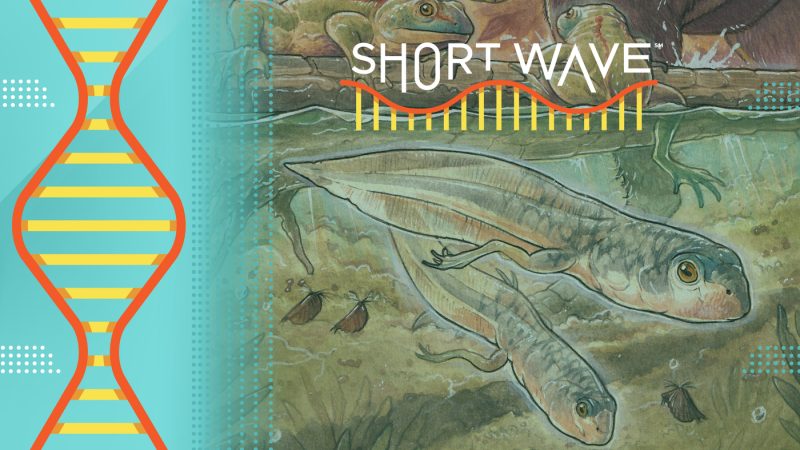Scientists have found the fossil of the earliest known tadpole : Short Wave : NPR

An illustration of Notobatrachus degiustoi tadpoles and adults in a mid-Jurassic period pond.
Gabriel Lío
hide caption
toggle caption
Gabriel Lío

An illustration of Notobatrachus degiustoi tadpoles and adults in a mid-Jurassic period pond.
Gabriel Lío
Frogs, like butterflies and salamanders, have what is called a “bi-phasic life cycle.” They undergo metamorphosis to grow from their larval stage, as a non-reproductive tadpole that swims underwater, to their adult stage, as a frog that can jump on land.
This drastic transformation is considered by scientists to be a marvel of nature — and now, experts know a little more about its history.
This week, a paper published in the journal Nature detailed a tadpole fossil that proves that tadpoles existed at least 161 million years ago, in the mid-late Jurassic period. This is 20 million years earlier than scientists previously thought.
“When I first saw the fossil, I said, ‘Okay, it is a tadpole, there is no doubt,'” says biologist Mariana Chuliver, one of the paper authors. “But then when I saw it under the binocular microscope, I said, ‘Okay, this is the best tadpole ever!’ Because up to now, there wasn’t any other type of fossil tadpole with the gill skeleton preserved.”
Well-preserved tadpole fossils like this one, found in Argentina, are especially hard to come by. Tadpoles are delicate creatures. They’re made of much more cartilage than a frog and this larval phase only lasts a few months before they transform.
Because of this, the study has been really exciting to tadpole experts across the world.
Take Richard Wassersug, a research scientist with expertise in amphibian and reptile fossils. “I read the paper this morning several times. I kept on looking at the pictures in amazement.” He recalls thinking, “‘Oh my God, this is real. This is a fossil tadpole. And this really looks like a tadpole.’ So few people know what the inside of tadpoles look like to appreciate what an incredible find this is.”
Because not all frog species undergo metamorphosis (some instead hatch as juvenile frogs straight from the egg), it has been a matter of debate whether frogs’ earliest ancestors were first tadpoles.
For Chuliver, this discovery hints that the early evolution of frogs might have been tightly related to metamorphosis. “Frogs have more than 6000 species. So if we think that the group from the very beginning had tadpoles and metamorphoses, it means that it was probably a successful strategy to survive,” she says.
Have another scientific discovery you want us to cover on a future episode? Email us at shortwave@npr.org — we might feature your idea on a future episode!
Listen to Short Wave on Spotify and Apple Podcasts.
Listen to every episode of Short Wave sponsor-free and support our work at NPR by signing up for Short Wave+ at plus.npr.org/shortwave.
This episode was produced by Jessica Yung, Rachel Carlson, and Jordan Marie-Smith. It was edited by Brent Baughman and Christopher Intagliata. It was fact-checked by Tyler Jones. The audio engineer was Becky Brown.









